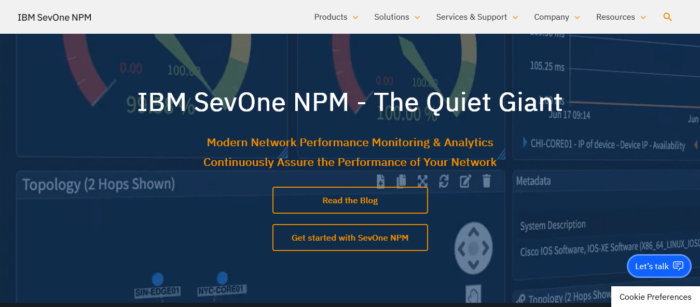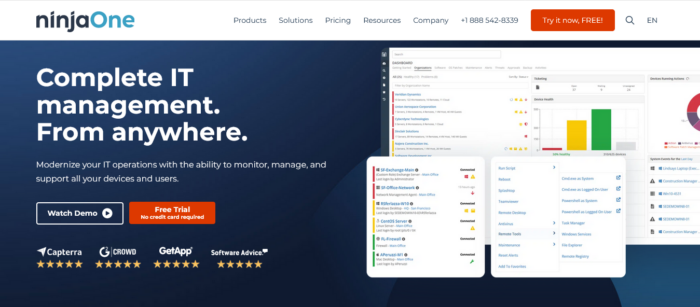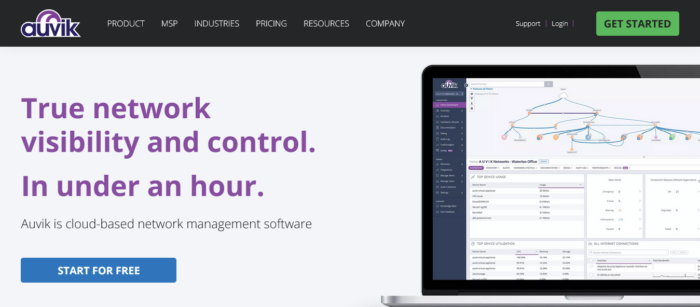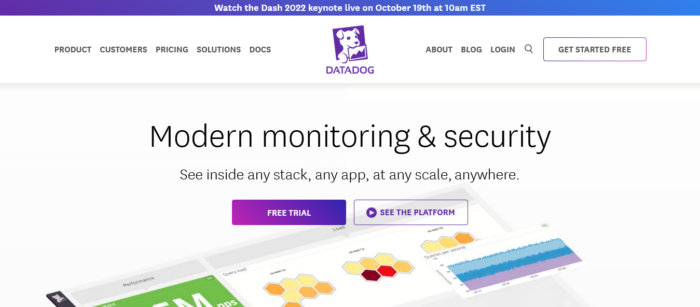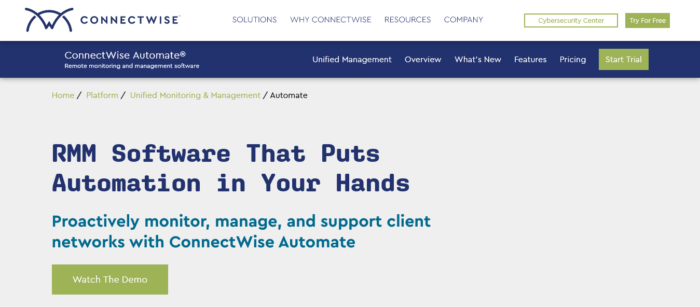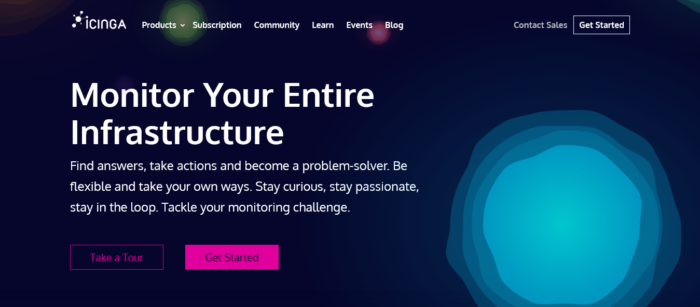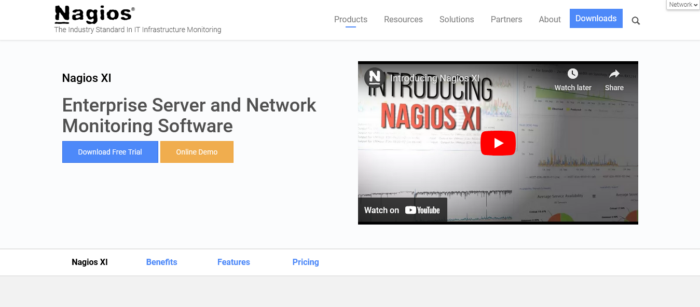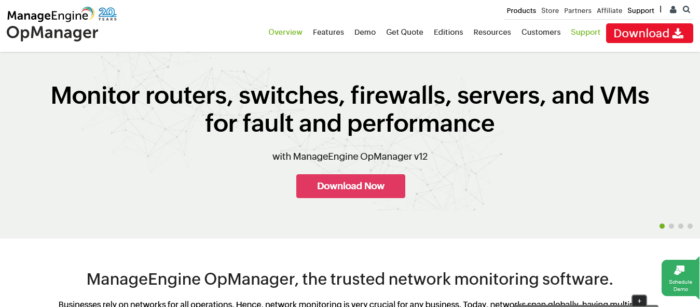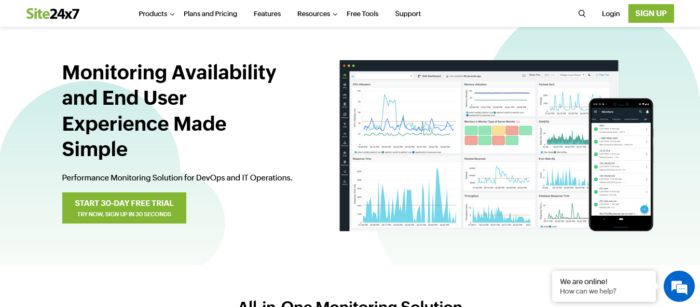Top SolarWinds Alternatives To Try: It’s getting harder and harder to keep track of, and monitor networks that keep growing, especially as cloud-only and hybrid networks become more popular. You can keep your network up and running with remote monitoring and management (RMM) tools. This is important because servers that break down and you don’t know about it are the worst. When you find out that the servers aren’t working and can’t figure out why that’s even worse. There are a lot of RMM tools out there that can find your network devices and tell you their status based on whether they are up and running. Some of these tools send out alerts, help you manage licenses, or collect analytics and diagnostic data so you can figure out what’s going on.
Recently, some tools have been made with machine learning (ML) technologies so that IT experts can learn new ways to address problems. SolarWinds is a big name in the markets for RMM and infrastructure monitoring. But recent events like the Solorigate hacks have brought the tool’s flaws to light. So, it only does some things. For example, due to the mistake of giving hackers a back door, the SolarWinds Orion software hack caused tens of thousands of users and business owners to think about which RMM tools they could use safely. There are, luckily, a number of more flexible and scalable solutions that don’t have the cloud of data breaches hanging over them. Here are 12+ SolarWinds alternatives that can help you find the right tool.
12+ Best SolarWinds Alternatives 2022 To Try
SolarWinds Alternatives to try in 2022.
1. Atera

Atera is a cloud-based service that helps managed service providers with a support package that includes modules for automating professional services and remote monitoring and management functions. Well, the package can monitor applications, servers, and networks. It also comes with other system management functions, such as software license and patch management. Compared to SolarWinds, this makes it more features. Both tools use SNMP processes, which offer network discovery, performance alerts, and real-time information about the status of network equipment. But while both install on-site, Atera is an online service while SolarWinds isn’t.
Atera doesn’t require you to maintain servers to host its software. This makes it even better for smaller managed service providers (MSPs) with small budgets since their network monitoring suite is fully available to those businesses. Atera also charges a subscription fee per technician for its services, so you can skip paying for everything at once. You can pay once a year or once a month, but once a year is cheaper. Atera is also easy to use, has a dashboard you can access from any browser, and can scale and support multiple networks in an organized way. This is one of the best SolarWinds alternatives to try.
2. Paessler PRTG
Paessler PRTG is a collection of different sensors or monitors that cover the monitoring of servers, networks, and applications. To use the solution correctly, you buy a certain number of the right sensors and turn on many of them. Plugins, add-ons, and scripts can be used to make Paessler PRTG do more. The PRTG system has APIs that let you use a custom-made program to talk to sensors. PRTG can also be used to automate tasks, but you’ll need ScriptRunner or other PowerShell programs to do so. The Paessler PRTG is built to monitor IT infrastructure, so it has no tools for maintenance or fixing problems. SolarWinds also has trouble with this. It is the main rival to SolarWinds. SolarWinds can be installed on Windows Server, but unlike SolarWinds, it can also be used in the cloud.
Both tools come with a free 30-day trial, are based on SNMP, and are very good at mapping the topology of a network. Along with wired networks, Paessler PRTG can also be used to monitor an eye on remote sites, WiFi networks, and cloud-based resources. SolarWinds sells functions like NetFlow monitoring and traffic shaping measures that can be done with Paessler PRTG sensors. This makes the base price of SolarWinds higher than that of Paessler PRTG. However, Paessler PRTG is more flexible, so if you only turn on 100 sensors, you don’t have to pay anything. Paessler PRTG uses behavior and root cause analysis to identify suspicious or malicious activity and triage problems quickly. It also has a drag-and-drop editor that makes custom views and reports easier. Smaller organizations can use the free version of Paessler PRTG.
3. SevOne
SevOne is a famous network monitoring tool that is different from SolarWinds in how it offers. SolarWinds runs on Windows and can be a virtual machine with visual displays like charts and graphs. SevOne, on the other hand, deploys as hardware directly to the data center to support scaling up. In addition, SevOne’s features aren’t separated into modules like SolarWinds’ are. For example, if you want to use NetFlow monitoring, you don’t have to access a new tab because it’s built into the dashboard. This is one of the best SolarWinds alternatives to try.
Also, SevOne lets you monitor NetFlow, SNMP, IPFIX, ICMP, and more. Unfortunately, SolarWinds doesn’t support NetFlow, so you must buy it separately. SevOne has an alert system that works based on a certain threshold. When pre-set alert thresholds are broken, the user is notified. SolarWinds uses email and SMS alerts instead of alerts based on a threshold. But you can still get alerts from SevOne via email, the dashboard, or its mobile app to stay up-to-date on what’s happening and be ready if something causes unexpected downtime.
4. NinjaOne
NinjaOne is a set of RMM tools that deliver separate modules for each package, unlike SolarWinds, whose service is spread over several units. This means that you have to buy multiple SolarWinds products to get the same services that NinjaOne offers. Plus, NinjaOne is made especially for MSPs, while SolarWinds has a brand designed N-Able that is made for MSPs. NinjaOne was designed with Managed Service Providers (MSPs) in mind. This means its users get multi-tenant support to keep their clients’ data separate. And NinjaOne’s setup allows credential management so that technicians don’t know the passwords for remote system accounts.
Even though it was built for MSPs, IT Operations departments can use NinjaOne to support more than one site. It’s also cloud-based, so the RMM software doesn’t have access to the local network. SolarWinds, on the other hand, is an on-premises package, so it’s best at monitoring the local system. NinjaOne also has a configuration manager and an automated patch manager. These packages are available in SolarWinds, but you must buy them separately and add them to the endpoint and network monitoring packages. Another big difference between the two tools is that NinjaOne has a ticketing system that lets tasks be assigned and scheduled. SolarWinds, on the other hand, uses email and SMS to send alerts but doesn’t have a ticketing system.
5. Splunk
Splunk is another great SolarWinds alternative. The network monitoring solution is highly regarded because it monitors your network in real-time by using machine data from devices connected to your network to measure how well the environment works. This solution offers a Search Processing Language (SPL) that can be used to look via the data in real-time and automatic detection tools. For example, if your network has patterns that don’t make sense, it will find these “anomalies.” You can spot common cyberattacks that can hurt your network and help identify performance and security problems that could cause big problems in the future. This is one of the best SolarWinds alternatives to try.
The look of Splunk is similar to that of SolarWinds. There are charts and graphs to show what’s going on, and the dashboard is easy to understand. On the other hand, Splunk has its alerting features, while SolarWinds has email and SMS notification alerts. With Splunk, you can set real-time alerts to know when things happen. You can also schedule alerts to have the least impact on performance while you keep an eye on network changes and monitor them. You can also set up alert conditions that tell the system when you want to be notified. This makes setting up the behavior you want to watch for easy. In the end, you’ll have a place where you’re involved when the system monitors for a problem.
6. NetBrain
NetBrain is less popular than some of the other RMM tools on this list, but it is still very useful, and its network discovery feature makes it stand out. The software has an auto-discovery feature that constructs a mathematical model from live data while gathering CLI information from devices connected to the network. This makes it different from SolarWinds’ SNMP polling, which can only get data from SNMP-enabled devices because NetBrain can get data from all devices. So, NetBrain lets you see more because you can see all the devices connected to the network. Also, NetBrain lets you make topology maps of your network whenever you want to see how it works. This is one of the best SolarWinds alternatives to try.
Live data is used to make these maps, so everything you see is correct. If the network changes, the platform automatically updates the map, so you don’t have to do it yourself. SolarWinds’ setup for making topology maps is similar to NetBrain’s, but NetBrain has a higher production value, so monitoring is better overall. NetBrain also has an alerting feature, but you can also configure a ticketing system that lets an analysis when an alert is raised. So you can troubleshoot smartly and determine where the problem is coming from. You get a Dynamic Network Map that shows you where the problem is, and you can configure escalation using APIs, so you don’t have to email log files to get quick answers. NetBrain also beats SolarWinds regarding automation because it has a clear edge.
7. ExtraHop
ExtraHop is an RMM solution that focuses on preventing threats by using innovative networking monitoring to help you get rid of unwanted data and see information about what’s happening. The tool’s dashboard makes monitoring easier, but its approach differs from that of SolarWinds and other providers because it focuses more on data analytics. But you can still look at usage data from the past in different time data, like by day, week, or more. In addition, ExtraHop has a system designed ExtraHop Addy, a machine learning service for wire data that runs in the cloud. This is one of the best SolarWinds alternatives to try.
This feature looks at your network’s usage data patterns to find performance problems and other oddities. This reduces the manual troubleshooting you must do to fix network problems. Plus, ExtraHop can Autodiscover devices across the network. Any new device added or connected is added to the monitoring environment, which supports over 50 protocols and almost all UDP and TCP systems. Finally, ExtraHop is high-performance because it can run traffic up to 100 Gbps and has a more interesting machine learning package than SolarWinds.
8. Auvik
Continuum and ConnectWise work together to give you full network management. Its new network monitoring solution is one of the few RMM tools that is well-made. Auvik is a high-performance RMM solution that offers real-time network mapping and inventory. This means that it keeps track of when new devices connect to your network and then analyses them after adding them to a topology map. On the map, you can click on each device to find out more about it, such as how fast it is. And the backup and restoration of device configurations are done automatically. This is one of the best SolarWinds alternatives to try.
So, if the device goes down, you will keep all your data. This adds new levels of security that are on par with what SolarWinds offers. Auvik also has password management and IPAM, similar to SolarWinds, because they let you see which devices are using your network subnets and which IPs are assigned to what. SolarWinds users must buy the IP Address Manager to get this feature. The Auvik password manager allows you to encrypt and store passwords in your network, so they are always easy to get to. So, if you want to monitor an eye on your network, you only have to remember one password. Again, this is not a feature that SolarWinds has.
9. Datadog
Datadog is a deep network monitoring and analytics tool that runs in the cloud and works with modern multi-vendor and cloud networks. Unlike SolarWinds, designed for on-premises network monitoring, the software has a long list of cloud integrations that can send data to and work with the solution’s reporting, recording, and analytics engine. Datadog can show you what’s happening inside apps, monitor traffic and user experience, and let you look at log data. This is one of the best SolarWinds alternatives to try.
You can also set up alerts to learn more about potential failure points in your network environment and use Datadog’s machine learning feature, which SolarWinds doesn’t have, to find problems you might not have known about at first. For example, suppose you need to troubleshoot an application or network problem. In that case, Datadog works with other debugging tools to dive deeply into your network’s performance history, find solutions, and figure out how to identify them.
10. ConnectWise Automate
ConnectWise Automate offers optimized RMM automation so that you can monitor and maintain your network from a single browser screen. The solution has the main interface where you can see all the devices, group them into logical groups, and then do things to them all at once or individually. In addition, you can get a good idea of each group at a glance thanks to clear icons and a wide range of filters that let you see the status of each machine and the machines as a whole.
One of the best things about it is that you can easily patch third-party apps, just like you can with assets in your operating system, and you don’t have to ask the user or device owner to do it very often. This tool is big support from SolarWinds because it offers automation and scripting and lets you make custom script sets that cover much ground. So, you can easily manage, patch, and configure your network with just a few clicks. This is one of the best SolarWinds alternatives to try.
11. LogicMonitor
Like Icinga, this cloud-based platform is designed to monitor an eye on infrastructure. But, unlike SolarWinds, it has an amazing number of cloud app and infrastructure integrations and markets itself to service providers and enterprise IT organizations. With the LogicMonitor, you get a full-stack monitoring service that works across multiple solutions or networks from different vendors. This is one of the best SolarWinds alternatives to try.
The solution starts with a basic core deployment package, which it builds on. At its core, LogicMonitor is a hybrid infrastructure in the cloud for performance monitoring. It also has a huge number of integrations that cover more than 2,000 platforms. For example, SolarWinds has email and SMS notifications, configuration monitoring systems, and more. LogicMonitor, on the other hand, has early warning features based on AI. The solution’s price is based on the level of support, the features, and the number of the devices you add to your network.
12. Icinga
Icinga is a free, open source solution that can be used to monitor an eye on infrastructure. Instead of selling product licenses, the company behind the product sells support subscriptions. This means that, unlike with SolarWinds, you will be charged less as your business grows. You can monitor an eye on as many machines as you want without paying a fee for each one. You can have as few as five machines or as many as 5,000 machines without paying anything. This is one of the best SolarWinds alternatives to try.
Also, Icinga prices its services based on their availability, so you don’t have to pay for support subscriptions. Instead, you pay based on the number of Icinga servers you run and the number of support cases as and when you need them, which is usually during work hours on weekdays or 24/7. The Icinga doesn’t measure how many devices you monitor. Also, it offers its basic monitoring engine, modules that add support for certificate monitoring, vSphere, business process monitoring, and other things, as well as a browser-based dashboard.
13. Nagios XI
One of the famous SolarWinds alternatives for network monitoring is Nagios XI. It is well-known among IT professionals for how well it works, and since it is free and open source, you don’t have to pay anything to use it. Of course, the network monitoring solution does have a paid version, but overall, Nagios XI is very powerful and is used almost everywhere.
Standard and Enterprise editions cost more, but you get the power of the Nagios core and a solution that is easier to use and more accessible. You also get advanced reporting features, summary reports, enhanced visualizations, custom actions, and more. The enterprise version gives you even more, features, like SAL reports, audit logging, capacity planning reports, and more.
14. ManageEngine OpManager
The ManageEngine OpManager is a network monitoring solution that monitors network devices. Unlike SolarWinds, which only lets you set up email and SMS notifications, you can monitor server availability, key network metrics, and VMs and set alarms and alerts. If you want to use more than three devices, you can leave the Free Edition and switch to the paid OpManager edition.
OpManager does both physical and virtual server monitoring and the usual real-time network monitoring. But it is similar to SolarWinds in that you can set multiple levels of thresholds to stage and adjust alerts to your needs. In addition, the RMM solution has a nice 3D view that lets you see all your physical racks and understand how they work. This is one of the best SolarWinds alternatives to try.
15. Site24x7
Site24x7 is a strong app for SolarWinds because it offers an all-in-one monitoring solution that deeply examines how apps work. The solution monitors an eye on many devices and apps, such as websites, app performance, servers, user experience, and network devices. For example, the user experience module is very popular because it is run by a small piece of JavaScript built into your app’s web pages. The module lets you find JavaScript errors, monitor performance, measure AJAX requests, and do much more.
It has IP-level monitoring, sold separately by SolarWinds, and gives deep insights into monitoring workload processes. You can see the devices for each performance of hardware or virtual machine, the devices for the network as a whole, and how the actual workload is performing in the apps. So, you’ll be able to identify, tune, and fix any tough performance problems in your network environment. This is one of the best SolarWinds alternatives to try.
Conclusion:
If you’ve been looking for a SolarWinds alternative to replace it after its security problems, or if you want to see how it compares to other options, these 12+ tools are worth looking into. Examine them based on the depth of the solution, the price per node, the devices you want to monitor, the servers you run, and the support they offer to find the best one for your needs.

